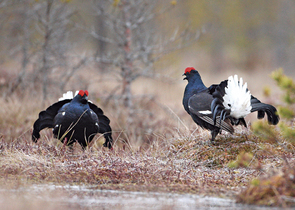Nature Conservation 3/2012 — 17. 10. 2012 — Research, Surveys and Data Management — Print article in pdf
Flousek J. & Volf O.: Are We Generous to the Black Grouse?

The Black Grouse (Tetrao tetrix) is a severely endangered species in the Czech Republic and its numbers decreased by 80% during the past 30 years (Fig. 1).
In the mid-20thcentury, Black grouses disappeared from low altitudes and most mountain populations have been also suffering from the decline. The dramatic decrease can be illustrated by the Black Grouse population in the Šumava/Bohemian Forest Mts., where its numbers drastically dropped from almost 1,300 to 50 displaying males during the past 35 years only. In the Czech Republic, the Black Grouse is threatened by changes in and fragmentation of suitable habitats, particularly in a border mountain range in the past heavily affected by industrial air pollution where dead forests have been step-by-step recovering. Human activities, for example extensive building of solar power plants and wind farms at sites inhabited by the Black Grouse (e.g., in the Krušné hory/Ore Mts. – Fig. 2) or recreation and sport activities, such as building of new ski grounds or doing sports in the open landscape (e.g., in the Krkonoše/Giant Mts. – Fig. 3) should also be mentioned. The most numerous and still viable populations have been maintained only in the Krušné hory/Ore Mts. and Krkonoše/Giant Mts. However, the negative changes, e.g.loss of lek sites or lower genetic diversity, have been found also in the above populations. The article presents important measures to be taken to actively protect Black grouses (strict assessment of development activities within the EIA, eliminating further suitable habitat fragmentation, peat-bog restoration and recovery, targeted management measures, maintaining exchanges of individuals among local populations, eliminating building of new ski grounds at Black grouse sites, visible marking of cable way and chair and ski lift ropes and cables, eliminating fencing forest patches by wire netting, etc.).

